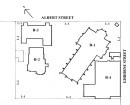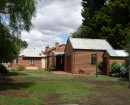BELLHOUSE IRON HOUSE
399 COVENTRY STREET SOUTH MELBOURNE, PORT PHILLIP CITY
-
Add to tour
You must log in to do that.
-
Share
-
Shortlist place
You must log in to do that.
- Download report




Statement of Significance
The Bellhouse iron house was erected in c1853 at 40 Moor Street, Fitzroy for Samuel Boswell. It was constructed according to the British patented system of iron founder Edward Taylor Bellhouse of Manchester. The only other surviving building on this system, or by this manufacturer, is the former ballroom at Balmoral Castle, Scotland, originally ordered from Bellhouse by Prince Albert.
The patent Bellhouse system was based on a number of cast iron structural and roof plumbing elements specifically sculpted to mate with the roof and wall cladding of 5 inch (130mm) pitch corrugated iron. The horizontal wall cladding ran into channels in the cast iron stanchions. Plates for fastening the top and bottom of the stanchions to the top and bottom plates.
The back top edges of the cast iron roof gutters are shaped to fit the corrugations of the roofing iron, and in a complete building, other cast iron members such as the ridge capping would have been similarly treated. The two windows are missing, but photographs of them survive. Internally the house was lined with lath and plaster, but was designed to have a horizontal board lining fixed to vertical timber pieces set into the hollow backs of the stanchions. The culturally significant fabric includes the whole of the building, though the cladding iron has largely been replaced and the structure now stands on timber baulks and a concrete slab.
The Bellhouse iron house was moved to its South Melbourne site in 1971 by the National Trust so as to save it from complete demolition, and has preserved the exterior shell and some elements to illustrate the interior as at Fitzroy, while also displaying schematically the sort of construction designed by the manufacturer,
How is it significant?
The Bellhouse iron house is of technical, architectural and historical significance to the State of Victoria.
Why is it significant?
The Bellhouse iron house is of technical and architectural significance as an extremely rare and relatively intact example of the innovative portable iron structures constructed according to the British patented system of Edward Taylor Bellhouse of Manchester. It is the only surviving building by ET Bellhouse in Victoria and Australia and is thought to be one of only two buildings constructed on the Bellhouse system surviving in the world. The other example is the former ballroom at Balmoral Castle, Scotland, originally ordered from Bellhouse by Prince Albert.
The Bellhouse iron house is of significance for its potential to be used to illustrate and educate on the technology of portable iron houses imported during the gold rushes, which are an important and increasingly rare aspect of Victoria?s heritage.
The Bellhouse iron house is of historical significance as one of the few surviving examples in Victoria of imported prefabricated iron houses of the 1850s. The use of imported prefabricated iron houses such as this in Victoria in the early 1850s reflected the rapid increase in population, scarcity of building materials, and high labour costs, all which were related to the rush for gold. Though not on its original site, the Bellhouse iron house provides an insight into one aspect of the migrant experience in the 1850s in Victoria.
-
-
BELLHOUSE IRON HOUSE - Assessment Against Criteria
Criterion A
The historical importance, association with or relationship to Victoria's history of the place or object.
The Bellhouse iron house is of historical significance as one of the few surviving examples in Victoria of imported prefabricated iron houses of the 1850s. The use of imported prefabricated iron houses such as this in Victoria in the early 1850s reflected the rapid increase in population, scarcity of building materials, and high labour costs, all which were related to the rush for gold. Though not on its original site, the Bellhouse iron house provides an insight into one aspect of the migrant experience in the 1850s in Victoria.Criterion B
The importance of a place or object in demonstrating rarity or uniqueness.
The Bellhouse iron house is of technical and architectural significance as an extremely rare and relatively intact example of the innovative portable iron structures constructed according to the British patented system of Edward Taylor Bellhouse of Manchester. It is the only surviving building by E.T. Bellhouse in Victoria and Australia and is thought to be one of only two buildings constructed on the Bellhouse system surviving in the world. The other example is the former ballroom at Balmoral Castle, Scotland, originally ordered from Bellhouse by Prince Albert.Criterion C
The place or object's potential to educate, illustrate or provide further scientific investigation in relation to Victoria's cultural heritage.
The Bellhouse iron house is of significance for its potential to be used to illustrate and educate on the technology of portable iron houses imported during the gold rushes, which are an important and increasingly rare aspect of Victoria's heritage.Criterion D
The importance of a place or object in exhibiting the principal characteristics or the representative nature of a place or object as part of a class or type of places or objects.Criterion E
The importance of the place or object in exhibiting good design or aesthetic characteristics and/or in exhibiting a richness, diversity or unusual integration of features.Criterion F
The importance of the place or object in demonstrating or being associated with scientific or technical innovations or achievements.Criterion G
The importance of the place or object in demonstrating social or cultural associations.Criterion H
Any other matter which the Council considers relevant to the determination of cultural heritage significanceBELLHOUSE IRON HOUSE - Permit Exemptions
General Exemptions:General exemptions apply to all places and objects included in the Victorian Heritage Register (VHR). General exemptions have been designed to allow everyday activities, maintenance and changes to your property, which don’t harm its cultural heritage significance, to proceed without the need to obtain approvals under the Heritage Act 2017.Places of worship: In some circumstances, you can alter a place of worship to accommodate religious practices without a permit, but you must notify the Executive Director of Heritage Victoria before you start the works or activities at least 20 business days before the works or activities are to commence.Subdivision/consolidation: Permit exemptions exist for some subdivisions and consolidations. If the subdivision or consolidation is in accordance with a planning permit granted under Part 4 of the Planning and Environment Act 1987 and the application for the planning permit was referred to the Executive Director of Heritage Victoria as a determining referral authority, a permit is not required.Specific exemptions may also apply to your registered place or object. If applicable, these are listed below. Specific exemptions are tailored to the conservation and management needs of an individual registered place or object and set out works and activities that are exempt from the requirements of a permit. Specific exemptions prevail if they conflict with general exemptions. Find out more about heritage permit exemptions here.Specific Exemptions:General Conditions:
1. All exempted alterations are to be planned and carried out in a manner which prevents damage to the fabric of the registered place or object.
2. Should it become apparent during further inspection or the carrying out of alterations that original or previously hidden or inaccessible details of the place or object are revealed which relate to the significance of the place or object, then the exemption covering such alteration shall cease and the Executive Director shall be notified as soon as possible.
3. If there is a conservation policy and plan approved by the Executive Director, all works shall be in accordance with it.
4. Nothing in this declaration prevents the Executive Director from amending or rescinding all or any of the permit exemptions.
Nothing in this declaration exempts owners or their agents from the responsibility to seek relevant planning or building permits from the responsible authority where applicable.
Exterior
* Minor repairs and maintenance to non original fabric
* Painting of previously painted walls
Interior
* Installation, removal or replacement of curtain track, rods, blinds and other window dressings.
* Installation, removal or replacement of smoke detectors.
* Installation of lighting
* Painting of previously painted walls and windows
* Installation of door furnitureBELLHOUSE IRON HOUSE - Permit Exemption Policy
All of the original fabric of the Bellhouse Iron House is of high significance. Any replacementor removal of, or alteration to that fabric, should be subject to a permit application.
-
-
-
-
-
ALBERT PARK PRIMARY SCHOOL
 Victorian Heritage Register H1629
Victorian Heritage Register H1629 -
BILTMORE (ALBERT PARK)
 Victorian Heritage Register H0475
Victorian Heritage Register H0475 -
ALBERT PARK RAILWAY STATION COMPLEX
 Victorian Heritage Register H1558
Victorian Heritage Register H1558
-
..esterville
 Yarra City
Yarra City -
1 Alfred Crescent
 Yarra City
Yarra City -
1 Barkly Street
 Yarra City
Yarra City
-
-












